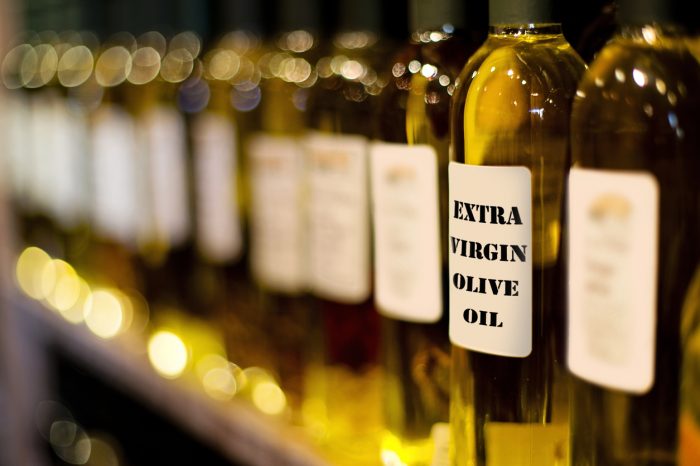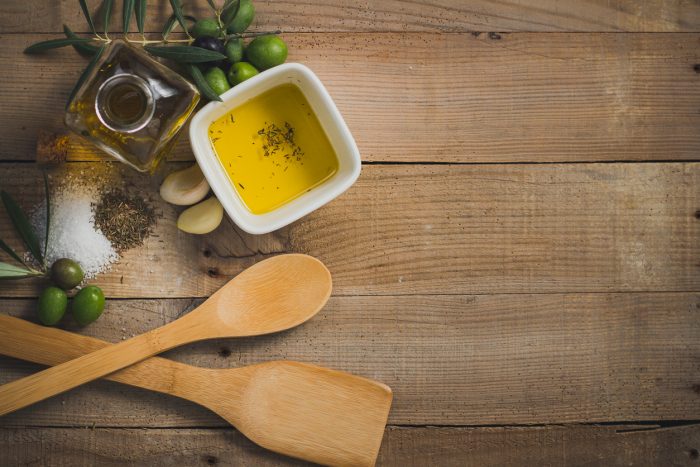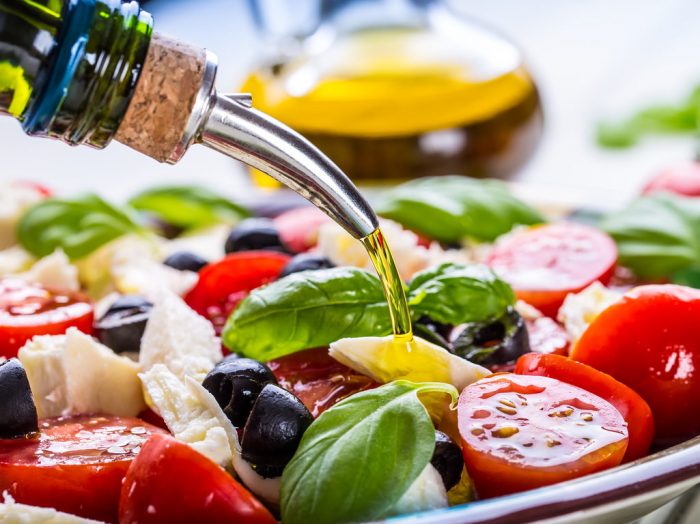The olive oil aisle in the supermarket can be confusing. Not only are there bottles of extra virgin olive oil or simple virgin olive oil, you can probably also find pure olive oil, olive oil, and light olive oil. So what is up with that and what kind of olive oil should you buy and use in your kitchen? Here is a handy-dandy guide.
Olive oil goes great in salads and vinaigrettes, with fish, bruschetta, pasta dishes and many many more. It has loads of health benefits and nutritious elements. Olive oil is rich in good fats and antioxidants like vitamin E, carotenoids, and phenols. It helps your bones get stronger, it minimizes inflammation, lowers your blood pressure and has anti-depressive qualities.
So getting in on the olive oil game is nothing but healthy skies ahead. But how do you pick one? What kind of olive oil should you use? The answer is complex.
Olive oils are different not because of the types of olives used, but by the process used to extract the oil from olives. There are also some differences because of the additives in the oil and the percentage of free oleic acid, which is actually the acidity of the olive oil.
If you look at bottles with different types of olive oil, you can actually see the difference. Extra virgin olive oil has a darker color, while regular olive oil has a lighter shade. But let’s dig in deeper and see what kind of olive oil you should go for.
What kind of olive oil can you find?
You are also probably going to hear that olive oil can be refined or unrefined. Usually, unrefined olive oil is the one that is pure and untreated. Unrefined olive oil is treated to remove impurities or other flaws, which makes it easier to sell. Refined oils tend to lose the nutrients, anti-inflammatories and antioxidants compounds which make the oil healthy. At the same time, refined olive oils lose part of their aroma and color. Which makes them better for dishes where you need some fat – like for fried anything -, but don’t want the slight bitterness of olive oil to add to the flavors.
So let’s not postpone the moment too much and dig in the olive oil mystery!

Four types of olive oil
1. Extra virgin olive oil
This is the purest one, with the lowest acidity (0.8 percent). That’s because it is produced from the first pressing of olives. It has the best taste, but it’s also the most expensive. How do you use it? As an accent for dishes. Extra virgin olive oil has a very full flavor, which means that you shouldn’t use it for, say, frying eggs or frying anything. The best use for it is over bruschetta or in dressings and vinaigrettes.
Extra tip for extra virgin: Pick the brand which has “cold press” on the label. If that is not mentioned, then the olive oil was extracted through heat. The heat changes the chemistry and quality of the oil.
2. Virgin olive oil
It has a higher acidity than extra virgin, about 2 percent. Virgin olive oil isn’t blended with any other oils from other sources. It is obtained only from olives, using only mechanical or other physical means, which don’t alter the oil in any way. Virgin olive oil has been washed, decanted, centrifuged, and filtered, and that’s the extent of its treatment.
It doesn’t have that strong a flavor as the extra-virgin, and its smoke point goes up a little. You can enjoy it uncooked and you can also use it if making soups, for instance. Or you can add it at the end of cooking dishes for a burst of flavor. You can also make marinades with it.

3. Pure olive oil or olive oil
This one is a blend of two oils: virgin olive oil and refined pomace oil. What is pomace, you ask? It’s an olive paste, the product of processing the leftovers of virgin olive oil extraction. It’s cheaper to produce, but keep in mind that it only has about 5-10 percent of virgin olive oil. The flavor is faint and you can use it for frying without a second thought. Just don’t expect too many health benefits.
4. Light olive oil
This is the one you should stay away from. The “light” adjective doesn’t mean that the oil is low-fat, it just means that the oil is made entirely from refined olive oil. These oils contain the same amount of fat and calories as any other olive oil: about 13 grams of fat and 120 calories per tablespoon. If it says on the bottle “100 percent pure olive oil”, then it might just be the lowest quality – have the least amount of virgin olive oil.
These light oils have been processed to the point of removing most of what makes extra-virgin olive oil what it is: natural color, aroma, flavor, and nutrients. Light olive oils have a neutral taste and higher smoke points. They can be used for baking, sautéing, grilling, and frying.






